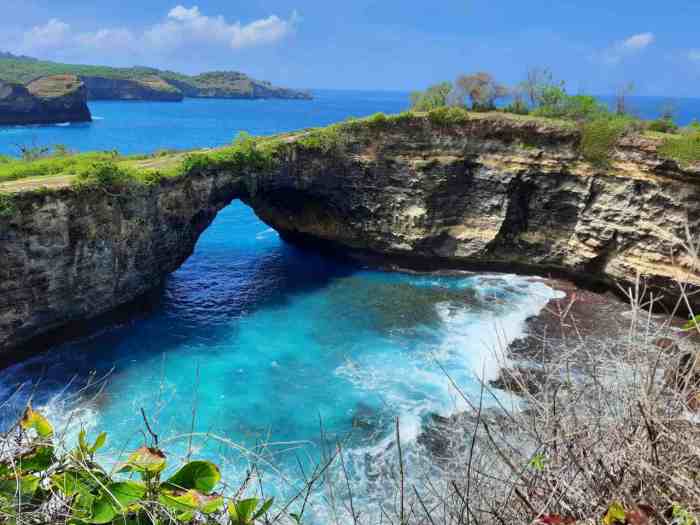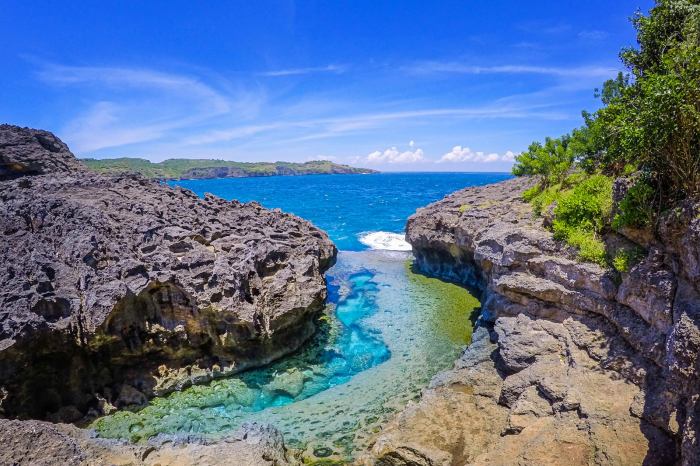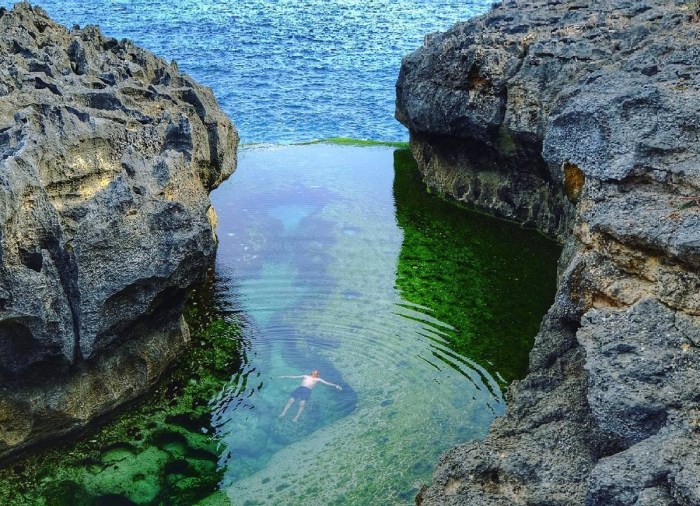Angel Billabong, a mesmerizing natural wonder, captivates with its unique geological formation and exceptional biodiversity. This pristine ecosystem serves as a sanctuary for endangered species and holds profound cultural significance for Indigenous communities.
Delve into the captivating story of Angel Billabong, exploring its geological origins, ecological importance, and the efforts made to preserve its natural and cultural heritage.
Angel Billabong Location and Formation

Angel Billabong is a unique and breathtaking natural wonder located within the remote and pristine Kimberley region of Western Australia. It is situated in the heart of the Purnululu National Park, a UNESCO World Heritage Site renowned for its extraordinary sandstone formations and diverse flora and fauna.
The formation of Angel Billabong is a testament to the power of geological processes over millions of years. The area was once a vast inland sea, and as the water receded, it left behind a thick layer of sandstone. Over time, the sandstone was eroded by wind and water, creating the intricate gorges and cliffs that characterize the Purnululu National Park.
Unique Environmental Conditions
Angel Billabong is not only a geological marvel but also a haven for a diverse range of plant and animal life. The permanent water source provided by the billabong attracts numerous species, including freshwater crocodiles, turtles, and a variety of birdlife.
The surrounding vegetation is equally diverse, with a mix of tropical rainforest and savannah woodlands.
Angel Billabong is a stunning waterhole located in the Kimberley region of Western Australia. The billabong is home to a variety of wildlife, including fish, turtles, and birds. Visitors can enjoy swimming, fishing, and camping at the billabong. The nearby Cikini Station offers guided tours of the area, as well as accommodations and dining options.
Angel Billabong is a must-visit destination for anyone exploring the Kimberley region.
Angel Billabong Biodiversity

Angel Billabong is renowned for its rich biodiversity, supporting a diverse array of flora and fauna. This unique ecosystem serves as a crucial habitat for numerous endangered and threatened species, playing a vital role in maintaining the ecological balance of the surrounding environment.
Flora, Angel billabong
The billabong’s diverse flora includes submerged and emergent aquatic plants. Submerged species, such as pondweeds and water lilies, provide essential oxygen and shelter for aquatic organisms. Emergent plants, including reeds and sedges, create dense stands that offer nesting sites for birds and protection for fish.
Fauna
Angel Billabong is a haven for a wide range of animal species. Notable avian residents include the endangered hooded plover, which nests on the billabong’s sandy shores. The billabong also supports a healthy population of waterbirds, including ducks, geese, and egrets.
Amphibians and reptiles, such as frogs and turtles, thrive in the billabong’s shallow waters and surrounding vegetation.
Ecological Significance
Angel Billabong’s ecological significance extends beyond its role as a habitat for endangered species. The billabong serves as a vital breeding ground for fish and other aquatic organisms, contributing to the overall health of the surrounding ecosystem. Additionally, the billabong’s vegetation helps filter pollutants from the water, improving water quality and supporting downstream communities.
Cultural Significance of Angel Billabong
Angel Billabong holds deep cultural and spiritual significance for Indigenous communities in the Kimberley region of Western Australia. The site is considered a sacred place and is associated with numerous traditional stories, ceremonies, and practices.
Traditional Stories and Beliefs
According to the Bunuba people, the traditional owners of the land where Angel Billabong is located, the billabong was created by the ancestral being, Ngururrpa. Ngururrpa is said to have traveled across the land, creating waterholes and rivers as he went.
Angel Billabong is believed to be one of these waterholes, and it is said to be a place where Ngururrpa’s spirit still resides.
The Bunuba people also believe that Angel Billabong is a place of healing. They believe that the water in the billabong has healing properties, and they often visit the site to bathe in the water or to drink from it.
Ceremonies and Practices
Angel Billabong is also a place where traditional ceremonies and practices are held. One of the most important ceremonies is the Ngururrpa Ceremony. This ceremony is held every year to celebrate the life of Ngururrpa and to ask for his protection.
Angel Billabong, a mesmerizing lagoon, captivates travelers with its pristine waters and serene ambiance. For those seeking a seamless journey to this idyllic destination, Hong Kong Airport offers a convenient gateway, connecting you to the wonders of Angel Billabong with ease.
Immerse yourself in the breathtaking beauty of this natural wonder, where tranquility awaits.
The ceremony involves singing, dancing, and storytelling, and it is a time for the Bunuba people to come together and share their culture.
In addition to the Ngururrpa Ceremony, other ceremonies and practices are also held at Angel Billabong. These ceremonies include smoking ceremonies, which are used to cleanse the area and to create a sacred space, and healing ceremonies, which are used to heal the sick and injured.
Angel Billabong, a breathtaking natural pool, offers a refreshing dip in the heart of North Bali. For a change of pace, venture to the nearby town of Singaraja , where you can explore its rich history and cultural heritage. Immerse yourself in the captivating blend of traditional Balinese architecture and modern amenities before returning to the tranquil shores of Angel Billabong for a rejuvenating swim.
Preservation and Protection
The cultural significance of Angel Billabong is recognized by the Australian government, and the site is protected under the Aboriginal and Torres Strait Islander Heritage Protection Act 1984. The act protects the site from development and ensures that it can continue to be used by Indigenous communities for cultural and spiritual purposes.
In addition to the government protection, the Bunuba people also work to preserve and protect the cultural heritage of Angel Billabong. They have established a ranger program to monitor the site and to prevent damage to the environment. They also work to educate visitors about the cultural significance of the site and to encourage them to respect the area.
Angel Billabong Conservation and Management

Angel Billabong faces various threats that endanger its unique biodiversity and ecosystem. These include habitat degradation, pollution, climate change, and invasive species.
To address these threats, several conservation and management strategies have been implemented. These include habitat restoration, pollution control, invasive species management, and sustainable tourism practices.
Challenges and Opportunities
The conservation and management of Angel Billabong present both challenges and opportunities. Challenges include limited resources, stakeholder conflicts, and the need for long-term monitoring and adaptive management.
Opportunities lie in the potential for community involvement, partnerships with research institutions, and the development of innovative management approaches.
Tourism and Recreation at Angel Billabong

Angel Billabong offers a unique and diverse range of tourism and recreational experiences that cater to nature enthusiasts, birdwatchers, and adventure seekers alike.
The pristine waters and stunning natural beauty of Angel Billabong attract visitors from far and wide. Responsible tourism practices are crucial to preserve the delicate ecosystem and cultural significance of this special place.
Types of Tourism and Recreational Activities
- Birdwatching:Angel Billabong is a haven for birdwatchers, with over 200 species of birds recorded within the area. The billabong and its surrounding wetlands provide a vital habitat for both resident and migratory birds.
- Nature Walks:Guided nature walks are available along the designated trails that wind through the billabong and its surrounds. Visitors can learn about the local flora, fauna, and the cultural significance of the area.
- Kayaking and Canoeing:Paddling through the tranquil waters of Angel Billabong offers a unique perspective of the ecosystem. Visitors can explore hidden channels, observe wildlife, and enjoy the serenity of the natural surroundings.
- Camping:Designated camping areas are available within the Angel Billabong National Park, allowing visitors to immerse themselves in the beauty of the natural environment.
- Picnicking:Visitors can enjoy a picnic in the designated areas around Angel Billabong, surrounded by stunning views and the sounds of nature.
Responsible Tourism Practices
To preserve the natural and cultural values of Angel Billabong, responsible tourism practices are essential. Visitors are encouraged to:
- Stay on designated trails and avoid disturbing wildlife.
- Dispose of waste properly in designated bins.
- Respect the cultural significance of the area and engage with local communities.
- Minimize noise levels to avoid disturbing wildlife and other visitors.
Economic Benefits of Tourism
Tourism at Angel Billabong provides significant economic benefits for local communities and the region.
- Job Creation:The tourism industry creates jobs in hospitality, guiding, and other related sectors.
- Revenue Generation:Tourism contributes to local revenue through accommodation, food and beverage sales, and guided tours.
- Infrastructure Development:Tourism investment can support the development of infrastructure such as roads, accommodation, and visitor facilities.
- Cultural Preservation:Tourism can promote the cultural heritage of the area and support local cultural practices.
Last Point

Angel Billabong stands as a testament to the intricate tapestry of life, where geological processes, ecological diversity, and cultural traditions intertwine. Its conservation and sustainable management are crucial for preserving this irreplaceable treasure for generations to come.
FAQ Resource
Where is Angel Billabong located?
Angel Billabong is situated in the Northern Territory of Australia, approximately 100 kilometers east of Darwin.
What makes Angel Billabong unique?
Angel Billabong is a rare and fragile ecosystem that supports a diverse range of flora and fauna, including many endangered and threatened species. It also holds significant cultural and spiritual value for Indigenous communities.
What are the threats facing Angel Billabong?
Angel Billabong faces threats such as climate change, pollution, and invasive species. These threats can impact the biodiversity and ecological balance of the billabong.